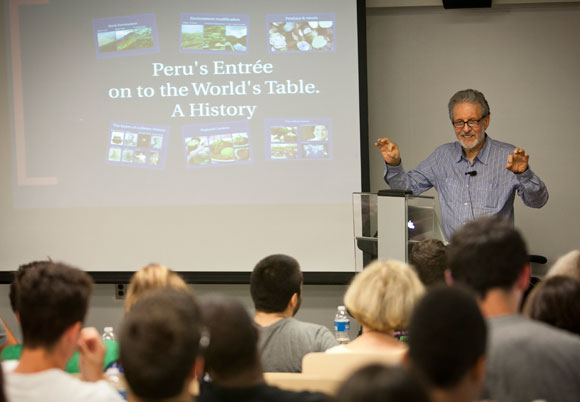
Peruvian cuisine is hot these days, and it's not just the tamales.
A spicy, creamy menu that has been 5,000 years in the making is gaining popularity around the United States, and a noted Peruvian food critic and writer came to Duke this past Tuesday to explain why. Luis Delboy said it all starts with the Peruvian people.
"Food is not only what you have to eat so that you can live, food comes from tradition, food comes from lots of people," Delboy said. "Food and language are what make us human."
Delboy's presentation explored the abundance of the diverse flora and fauna of Peru, the influence other cultures such as Chinese, African and European have had on Peruvian cuisine and the culinary boom that is Peruvian food.
"When you go to the market here [in America] you will find probably three or four varieties of potatoes," Delboy said. "In Lima, your normal run-of-the-mill market will have between 15 and 20 different types of potatoes and dozens of other roots."
The presentation was accompanied by a Peruvian lunch of chicken tamales, pepper and cheese tamales, two types of empanadas, salad, and desert.
Although the traditional Peruvian dish of cuy or spit-roasted guinea pig has not yet been popularized in the US, increasingly sought-after products such as quinoa and freeze dried potatoes are evidence of the expansion of Peruvian cuisine.
All of this marvelous culinary diversity comes out of an unusual Peruvian environment that has shaped both the culture and the cuisine, Delboy said.
"Those tamales you are eating are not only Mexican, they are also Peruvian," said Delboy as students and faculty savored the creamy, spicy dish served with kale salad and marinated avocados. "We have been eating them probably for four or five thousand years.
"Quinoa has also been in fashion in Peru for 5,000 years or so," Delboy said. "It can grow at 12,000 feet."
Delboy began writing columns in a friend's magazine in 1975 until the magazine stopped publication after the fourth issue. With the creation of the World Wide Web, Delboy returned to food writing, this time online.
"I wanted to write eight to 10 things," Delboy said. "I started with ceviche because I'd eaten so much of it."
His online writing career lasted much longer. In 2003 he created the website Cebicheria Virtual Don Lucho, making it one of the first food webpages written in Spanish. He later published his blog La Cocina de Leticia y Don Lucho, which held 300 recipes and reached about 5,000 people daily before it was temporarily shut down for revisions. It will be re-launched later this year.
Delboy said he hopes to see continued growth in the world's knowledge of Peruvian food. He said Lima's Mistura festival, the largest food fair in Latin America, attracted more than 600,000 foodies last year and is considered a mecca for culinary superstars.
"I would like to meet some influential cooks to tell them cooking is not about making pretty things or making things taste good," Delboy said. "It's about food and giving things to people that are good for their bodies."
The event was sponsored by the Office of the Deans in Trinity College of Arts and Science, the Summer Program, Latino and Latina Studies in the Global South, and the Spanish Language Program.
Leah Montgomery, a rising senior at NCCU, is an intern working this summer in the Duke Office of News and Communication.
Below: Luis Delboy presents a history of Peruvian cuisine. Above, before the talk, visitors helped themselves to tamales and Peruvian salads. Photos by Megan Morr/Duke University Photography
